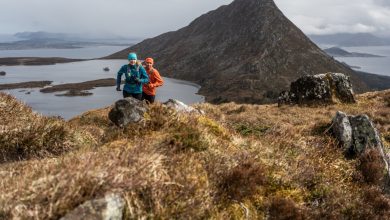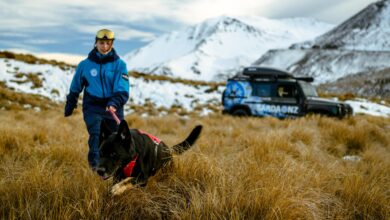Discover Te Ara Mangawhero – a Ngāti Rangi treasure – the newest trail of the Mountains to Sea – Ngā Ara Tūhono Great Ride of New Zealand
Q&A with Helen Leahy

Cyclists enjoying Te Ara Mangawhero with Mt Ruapehu in the background
Pou Ārahi / Chief Executive of Te Tōtarahoe of Paerangi Trust and Ngā Waihua o Paerangi Trust for Ngāti Rangi

Image caption: Helen Leahy, Pou Ārahi / Chief Executive of Te Tōtarahoe of Paerangi Trust and Ngā Waihua o Paerangi Trust for Ngāti Rangi
Tell us about Te Ara Mangawhero – what is the new trail all about, where is it located and when does it open?
Te Ara Mangawhero creates a journey through nature between the alpine environment near Tūroa and the historic Ohakune Old Coach Road, connecting Tūroa and Ohakune on Mounga Ruapehu.
The trail follows sections of the historic Bennett and Punch bush tramway, originally used to transport timber through the dense forests of the area in the late 19th and early 20th centuries. The tramway played a significant role in the local economy, helping shape the growth of Ohakune.
The trail gently ascends through the ngahere, crossing the Mangawhero stream over a number of bridges, through wetlands and regenerating tussocks. Even today, you’ll notice old stumps and remnants of iron pins from tramway sleepers scattered along the path.
For our whānau and uri, as well as the local community and visitors, Te Ara Mangawhero opens up new parts of our whenua and exposes them to landscapes many have never seen before.
Te Ara Mangawhero brings to fruition the dreams and aspirations of those who came before us – to care for Koro Ruapehu; to play; to walk; to bike; to take time to enjoy the pristine natural landscape.
The first stage of the trail is an 11.4km loop track linking to Ohakune Old Coach Road, and was officially opened on November 1st 2024, by Hon Tama Potaka – Minister for Conservation and Minister for Māori Development.
Can you share why Te Ara Mangawhero is significant for people and place?
Ngāti Rangi has been involved in the Te Ara Mangawhero kaupapa for over a decade; from initial discussions and active participation to planning and leading the detailed trail design and construction.
As tangata tiaki, Ngā Waihua o Paerangi Trust wanted to establish, manage, and maintain the trail to enhance connection, care and respect for the location while providing employment and growth opportunities for our people.


Image caption: Edifice Contractors are installing a 32-meter multi-span bridge, on foundations that once held the tramway bridge. Predominantly used back in the 80’s and put to rest after the logging had finished in that area, Te Ara Mangawhero has truly brought this part of history back to life.
The aim has been to build a sustainable trail that has minimal impact, resists erosion through proper design, and blends with the environment.
Building on the old tramway allowed the trail to be created with minimal impacts on the taiao and whenua using sustainable construction practices which included transplanting native seedlings back into the ngahere with eco-friendly materials from local suppliers.
For Ngati Rangi, as the sacred mountain clan, give expression to Te Waiū-o-te-Ika, the source of life.
Ko te Kāhui Maunga te mātāpuna o te ora.
Te Ara Mangawhero is a lived embodiment of our guiding principles as tangata tiaki; Living, nurturing waters, providing potency to the land and its people from source to tributary to the ocean.
Ko ngā wai tiehu ki ngā wai riki, tuku iho ki tai hei waiū, hei wai tōtā e.
The Mangawhero Awa which the trail weaves across, is of fundamental importance to Ngāti Rangi, as is the need to protect the mana and mouri of the awa and the wellbeing of the surrounding environment.
This trail is kaitiakitanga in action. It embodies the dreams of the tupuna, to connect to Koro Ruapehu, to protect his tapu and mana, and share this majestic landscape with whānau, the wider community and national and international visitors alike.
Tongariro National Park is also one of only 29 sites in the world with UNESCO dual World Heritage status and is incredibly unique in New Zealand. Its World Heritage status was granted for its natural landscape values and the special significance of the Park’s mountains and cultural landscape to the iwi who are tangata tiaki of this place.
What should cyclists and walkers be mindful of and prepare for on the trail?
Walkers and cyclists need to prepare for the alpine area, where the weather may change at any time.
They also need to be mindful that it is a UNESCO Dual World Heritage Park, where you are expected to stick to the trail, take nothing but photos and leave nothing behind.
The trail traverses and showcases a wide range of ecologically and culturally significant forest and river habitats on the lower slopes of Ruapehu where the wellbeing of the taiao and indigenous ecosystems is of the utmost priority.
The storytelling component of the trail provides an opportunity for Ngāti Rangi to tell our stories first hand. Te Ara Mangawhero will help to ensure that the Ngāti Rangi narrative is shared with and understood by visitors to our region and locals alike.
What are some of your favourite highlights?
The cultural identity of Ngāti Rangi is linked to the essence of Matua te Mana or Koro Ruapehu. The lifeblood of the people cascades as waters from his slopes, and his peaks above are the sacred altar for Ngāti Rangi. The vision statement for Ngāti Rangi is:
“Kia mura ai te ora o Ngāti Rangi ki tua o te 1,000 tau.
Ngāti Rangi continues to vibrantly exist in 1,000 years”
In this respect, at one point in the trail you cross a bridge and suddenly the majestic presence of Matua te Mana is right before you. It is truly breathtaking.
That is what it is to vibrantly exist – to be immersed in the wonder of the whenua; to drink from the purity of the awa, to lift our vision to the mountain peaks and beyond.

Image caption: Group of kaimahi from Ngā Waihua o Paerangi who test-walked the early stages of Te Ara Mangawhero on 14 May 2024.
What are the next steps for Te Ara Mangawhero?
The approach being taken is staged, and light on the land in using previously disturbed trail routes. Ngāti Rangi ensures that the whenua is cared for during the development with the utmost respect.
Efforts are now underway to secure additional funding for the second phase of Te Ara Mangawhero, which will complete the 21.4km trail to Tūroa ski field.
This development will also provide mahi for local people and opportunity for economic development for our region.
Fast facts about Te Ara Mangawhero
· Start/finish: 1 Ohakune Mountain Road, Ohakune
· Distance 11.4 km (phase 1)
· Grade 2 easy
· Time 2 hrs
· 4 season ride
· Location: Ohakune, Ruapehu
For more info about Te Ara Mangawhero and the Mountains to Sea Ngā Ara Tūhono connected pathways, visit https://www.mountainstosea.nz/te-ara-mangawhero/







